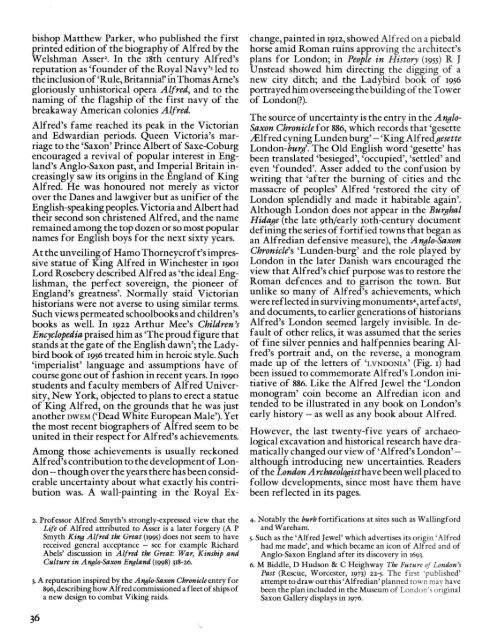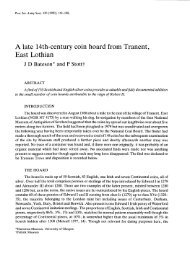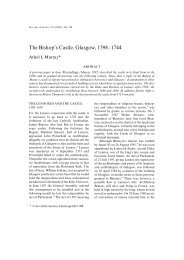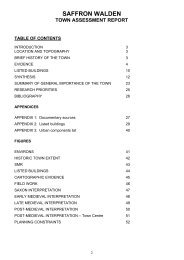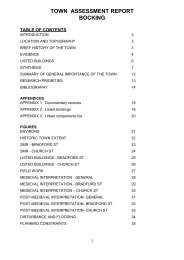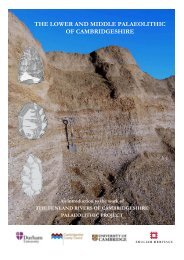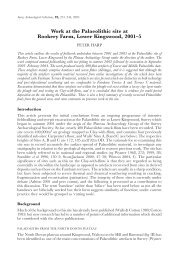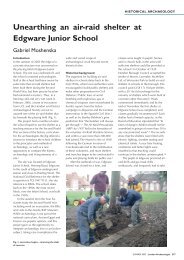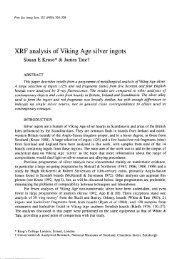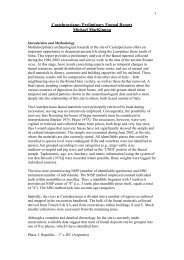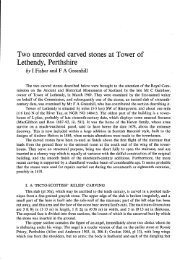King Alfred's London and London's King Aifred
King Alfred's London and London's King Aifred
King Alfred's London and London's King Aifred
You also want an ePaper? Increase the reach of your titles
YUMPU automatically turns print PDFs into web optimized ePapers that Google loves.
ishop Matthew Parker, who published the first<br />
printed edition of the biography of Alfred by the<br />
Welshman Asser-, In the rsth century <strong>Alfred's</strong><br />
reputation as 'founder of the Royal Navy'i led to<br />
theinclusionof'Rule,Britannia!' in ThomasArne's<br />
gloriously unhistorical opera Alfred, <strong>and</strong> to the<br />
naming of the flagship of the first navy of the<br />
breakaway American colonies Alfred.<br />
<strong>Alfred's</strong> fame reached its peak in the Victorian<br />
<strong>and</strong> Edwardian periods. Queen Victoria's marriage<br />
to the 'Saxon' Prince Albert of Saxe-Coburg<br />
encouraged a revival of popular interest in Engl<strong>and</strong>'s<br />
Anglo-Saxon past, <strong>and</strong> Imperial Britain increasingly<br />
saw its origins in the Engl<strong>and</strong> of <strong>King</strong><br />
Alfred. He was honoured not merely as victor<br />
over the Danes <strong>and</strong> lawgiver but as unifier of the<br />
English-speakingpeoples. Victoria <strong>and</strong> Albert had<br />
their second son christened Alfred, <strong>and</strong> the name<br />
remained among the top dozen or so most popular<br />
names for English boys for the next sixty years.<br />
Atthe unveilingofHamoThorneycroft's impressive<br />
statue of <strong>King</strong> Alfred in Winchester in 1901<br />
Lord Rosebery described Alfred as 'the ideal Englishman,<br />
the perfect sovereign, the pioneer of<br />
Engl<strong>and</strong>'s greatness'. Normally staid Victorian<br />
historians were not averse to using similar terms.<br />
Such views permeated schoolbooks <strong>and</strong> children's<br />
books as well. In 1922 Arthur Mee's Children's<br />
Encyclopediapraised him as 'The proud figure that<br />
st<strong>and</strong>s at the gate of the English dawn'; the Ladybird<br />
book of 1956 treated him in heroic style. Such<br />
'imperialist' language <strong>and</strong> assumptions have of<br />
course gone out of fashion in recent years. In 1990<br />
students <strong>and</strong> faculty members of Alfred University,<br />
New York, objected to plans to erect a statue<br />
of <strong>King</strong> Alfred, on the grounds that he was just<br />
another DWEM ('Dead White European Male'). Yet<br />
the most recent biographers of Alfred seem to be.<br />
united in their respect for <strong>Alfred's</strong> achievements.<br />
Among those achievements is usually reckoned<br />
<strong>Alfred's</strong> contribution to the developmentof <strong>London</strong><br />
--though over the years there has been considerable<br />
uncertainty about what exactly his contribution<br />
was. A wall-painting in the Royal Ex-<br />
2 . Professor Alfred Smyth's strongly-expressed view that the<br />
Life of Alfred attributed to Asser is a later f orgery (A P<br />
Smyth <strong>King</strong> Alfred the Great (1995) does not seem to have<br />
received general acceptance - see for example Richard<br />
Abels' discussion in Alfred the Great: War, Kinship <strong>and</strong><br />
Culture in Anglo-Saxon Engl<strong>and</strong> (1998) 318-26.<br />
3. A reputation inspired by the A nglo-Saxon Chronicleentry f or<br />
896 , describing how Alfred commissioned a fleet ofships of<br />
a new design to combat Viking raids.<br />
change, painted in 1912, showed Alfred on a piebald<br />
horse amid Roman ruins approving the architect's<br />
plans for <strong>London</strong>; in People in H istory (1955) R J<br />
U nstead showed him directing th e digging of a<br />
new city ditch; <strong>and</strong> the Ladybird book of 1956<br />
portrayed himoverseeing thebuildingofth eTower<br />
of <strong>London</strong>(?).<br />
The source of uncertainty is the entry in the Anglo<br />
Saxon Chronicle for 886, which records that 'gesette<br />
.!Elfred cyning Lunden burg' -- '<strong>King</strong> Alfredgesette<br />
<strong>London</strong>-burg'. The Old English word 'gesette' has<br />
been translated 'besieged', 'occupied', 'settled' <strong>and</strong><br />
even 'founded'. Asser added to the confusion by<br />
writing that 'after the burning of cities <strong>and</strong> the<br />
massacre of peoples' Alfred 'restored the city of<br />
<strong>London</strong> splendidly <strong>and</strong> made it habitable again'.<br />
Although <strong>London</strong> does not appear in the Burghal<br />
Hidage (the late oth/early roth-century document<br />
defining the series of fortified towns that began as<br />
an Alfredian defensive measure), the Anglo-Saxon<br />
Chronicle's 'Lunden-burg' <strong>and</strong> the role played by<br />
<strong>London</strong> in the later Danish wars encouraged the<br />
view that <strong>Alfred's</strong> chief purpose was to restore the<br />
Roman defences <strong>and</strong> to garrison the town. But<br />
unlike so many of <strong>Alfred's</strong> achievements, which<br />
were reflected in surviving monuments-,artefacts',<br />
<strong>and</strong> documents, to earlier generations of historians<br />
<strong>Alfred's</strong> <strong>London</strong> seemed largely invisible. In default<br />
of other relics, it was assumed that the series<br />
of fine silver pennies <strong>and</strong> halfpennies bearing AIf<br />
red's portrait <strong>and</strong>, on the reverse, a monogram<br />
made up of the letters of 'LVNDONIA' (Fig. I) had<br />
been issued to commemorate <strong>Alfred's</strong> <strong>London</strong> initiative<br />
of 886. Like the Alfred Jewel the '<strong>London</strong><br />
monogram' coin become an Alfredian icon <strong>and</strong><br />
tended to be illustrated in any book on <strong>London</strong>'s<br />
early history -- as well as any book about Alfred.<br />
However, the last twenty-five years of archaeological<br />
excavation <strong>and</strong> historical research have dramatically<br />
changed our view of'<strong>Alfred's</strong> <strong>London</strong>' -although<br />
introducing new uncertainties. Readers<br />
ofthe <strong>London</strong> A rcbaeoloqisthave been well placed to<br />
follow developments, since most have them have<br />
been reflected in its pages.<br />
4-.Notably the burh fortifications at sites such as Wallingford<br />
<strong>and</strong> Wareham.<br />
5. Such as the 'Alf red Jewel ' which ad vert ises its origin 'Alf red<br />
had me made', <strong>and</strong> wh ich became an icon of Alfred <strong>and</strong> of<br />
Anglo-Saxon Engl<strong>and</strong> after its discovery in 1693-<br />
6. M Riddl e, D Hudson & C Heighway The Future of <strong>London</strong>'s<br />
Past (Rescue, Worcester, 1973) 22 -5. The f irst 'published'<br />
attempt to draw outthis'Alfredian' planned town may have<br />
been the plan included in th e Museum of <strong>London</strong>' 5 original<br />
Saxon Gallery display s in 1976.


